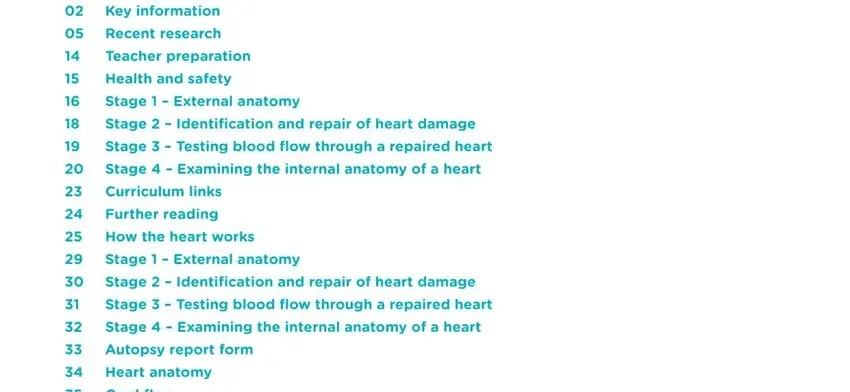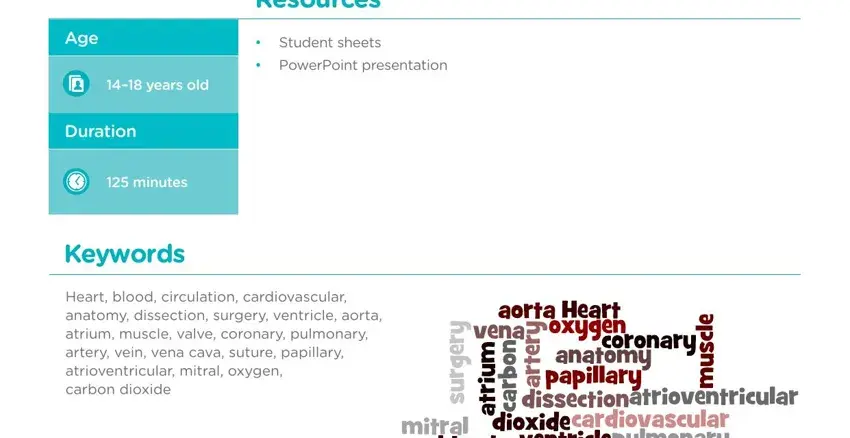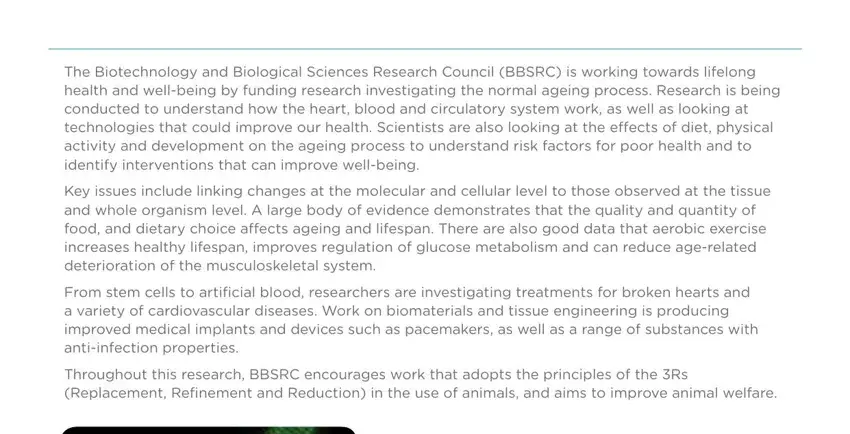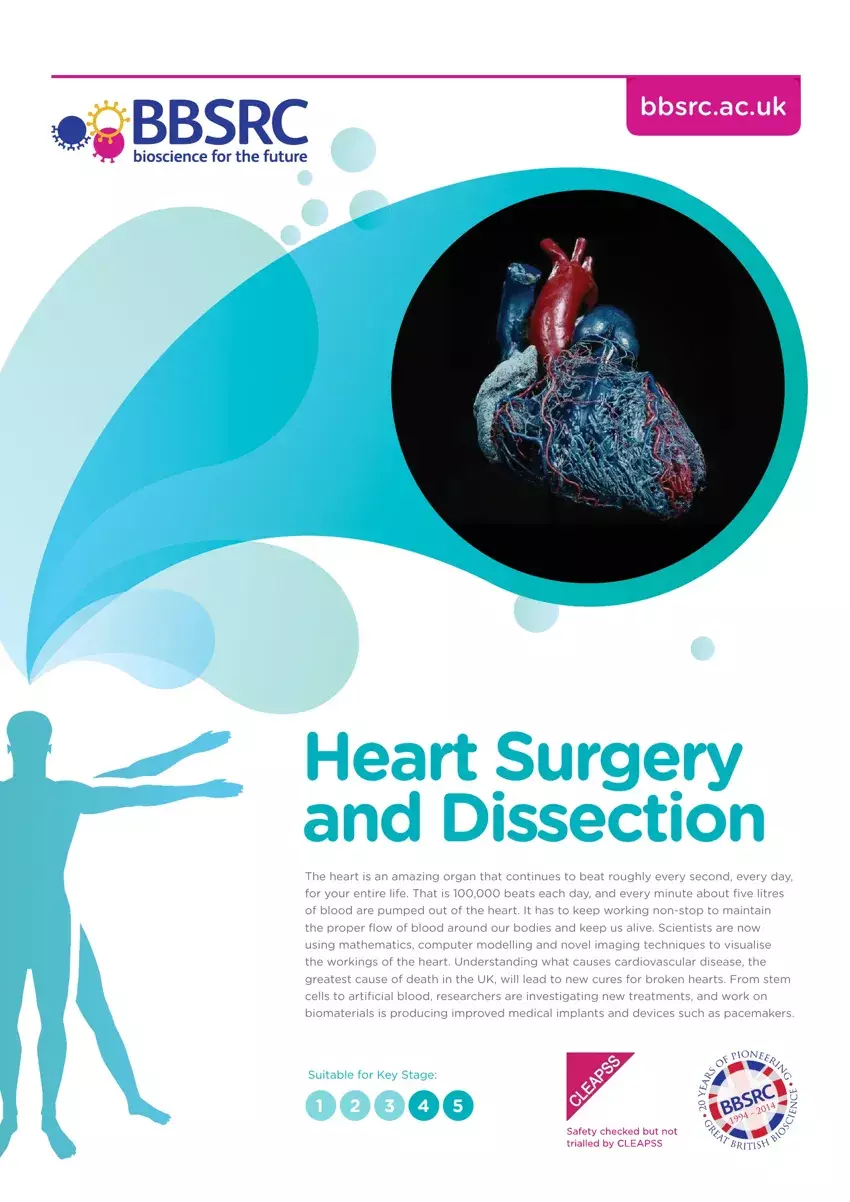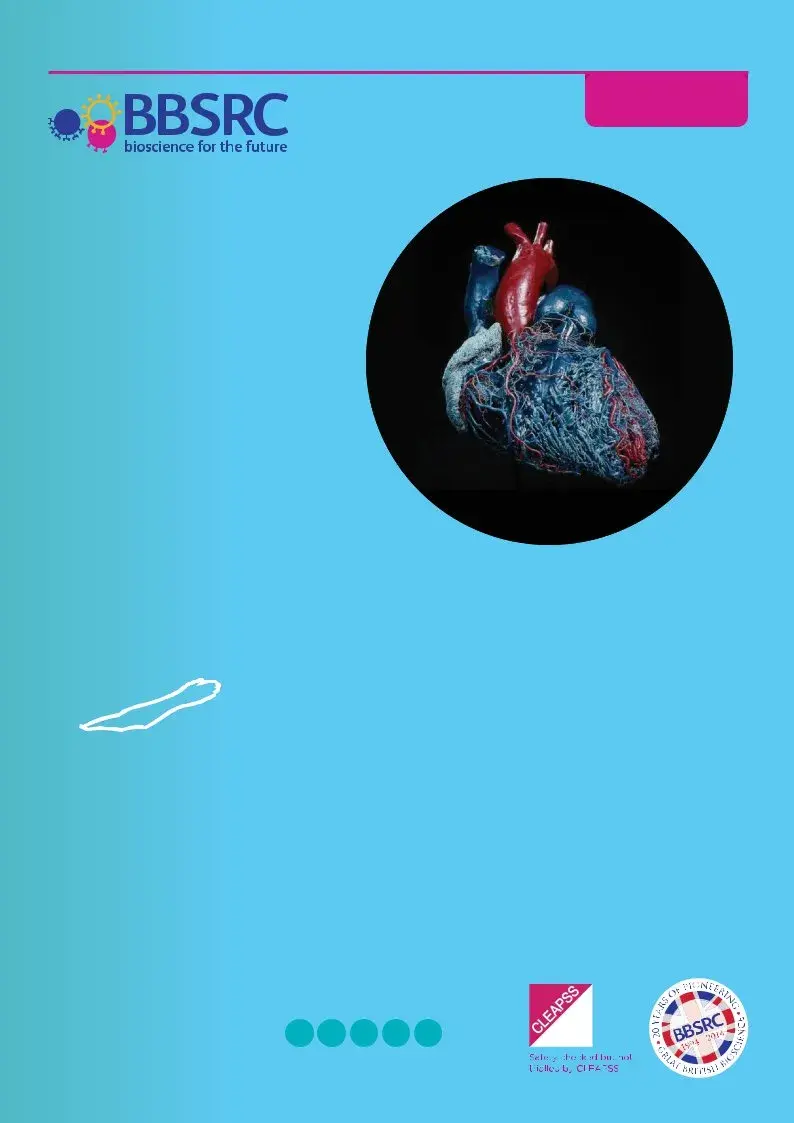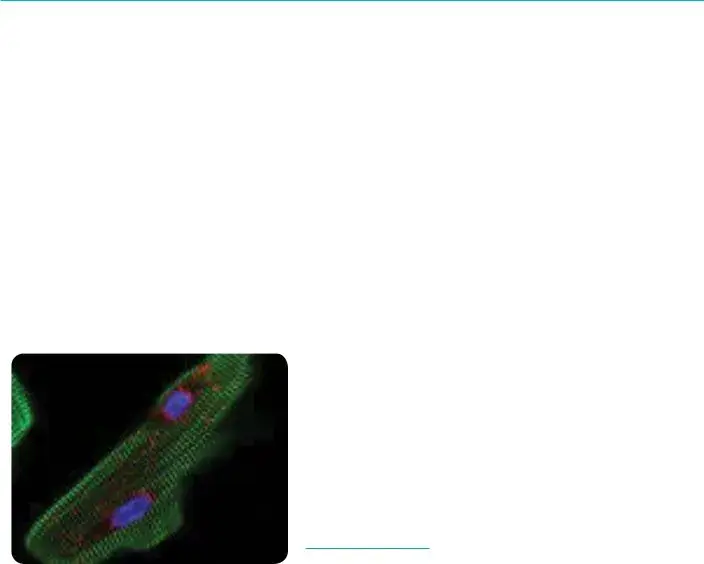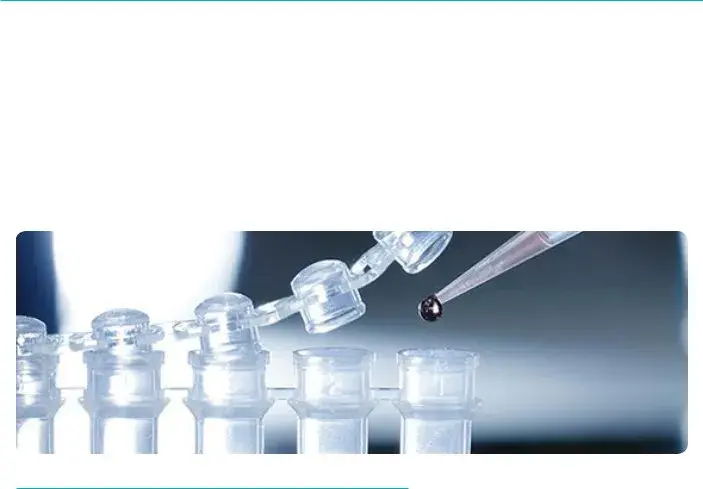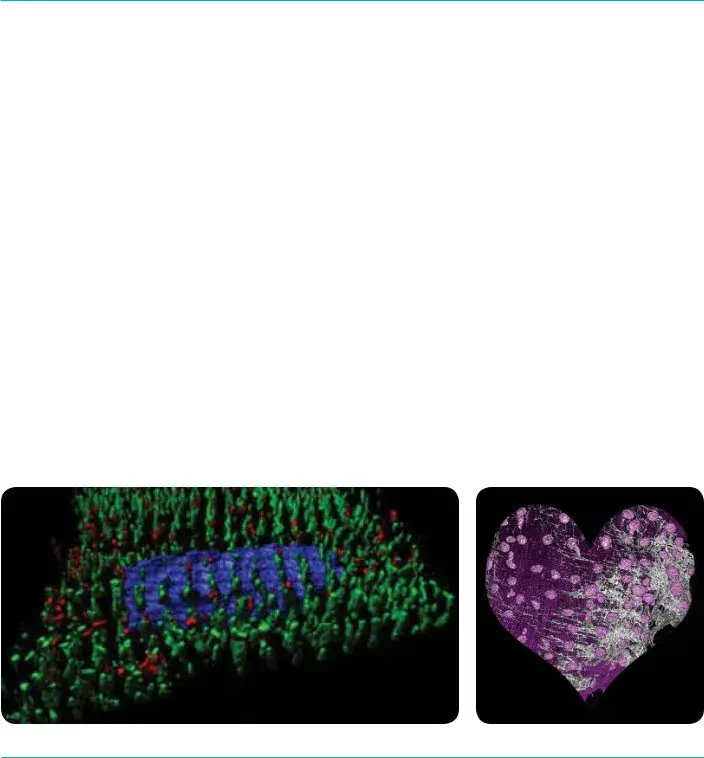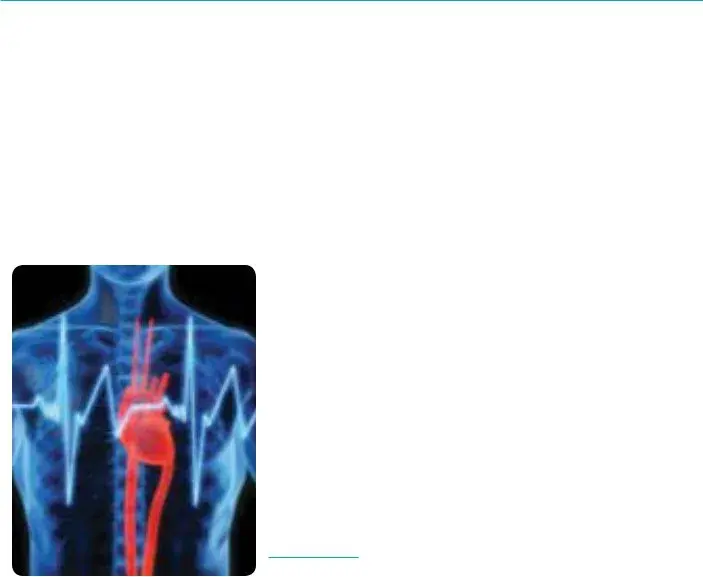bbsrc.ac.uk
Heart Surgery
and Dissection
The heart is an amazing organ that continues to beat roughly every second, every day, for your entire life. That is 100,000 beats each day, and every minute about five litres of blood are pumped out of the heart. It has to keep working non-stop to maintain the proper flow of blood around our bodies and keep us alive. Scientists are now using mathematics, computer modelling and novel imaging techniques to visualise the workings of the heart. Understanding what causes cardiovascular disease, the greatest cause of death in the UK, will lead to new cures for broken hearts. From stem cells to artificial blood, researchers are investigating new treatments, and work on biomaterials is producing improved medical implants and devices such as pacemakers.
Suitable for Key Stage:
1 2 3 4 5
Contents
02Key information
05Recent research
14Teacher preparation
15Health and safety
16Stage 1 – External anatomy
18Stage 2 – Identification and repair of heart damage
19Stage 3 – Testing blood flow through a repaired heart
20Stage 4 – Examining the internal anatomy of a heart
23Curriculum links
24Further reading
25How the heart works
29Stage 1 – External anatomy
30Stage 2 – Identification and repair of heart damage
31Stage 3 – Testing blood flow through a repaired heart
32Stage 4 – Examining the internal anatomy of a heart
33Autopsy report form
34Heart anatomy
35Card flow
36Circulation worksheet
37Missing Words
39Wordsearch
40Crossword
41Answers
44Glossary
View online
Scan the QR Code.
Science topics
Physiology, anatomy, cardiovascular system, exchange and transport, pathology, disease and injury
Resources
Age |
|
• |
Student sheets |
|
|
• |
PowerPoint presentation |
|
14–18 years old |
|
|
|
|
|
|
|
Duration
125 minutes
Keywords
Heart, blood, circulation, cardiovascular, anatomy, dissection, surgery, ventricle, aorta, atrium, muscle, valve, coronary, pulmonary, artery, vein, vena cava, suture, papillary, atrioventricular, mitral, oxygen,
carbon dioxide
Learning outcomes
Students will be able to:
•Identify the internal and external anatomy of a heart
•Dissect a heart and be able to model the techniques of a heart surgeon
•Discuss heart diseases and disorders, describe how they occur, and name risk factors and possible preventative measures.
•Sheep or lamb hearts
•Rubber tubing and syringe
•Dissecting equipment – trays, pins or cocktail sticks, forceps, blunt probes, round-ended scissors
•Masking tape or stickers
•Marker pens
•Washing up bowls or access to sinks
•Curved needles
•Dental floss or fishing line
•Rulers
•Eye protection
•Waterproof aprons
•Balance
Optional
•Disposable nitrile or vinyl gloves
•Scalpels
•Slides featuring heart muscle tissue and cardiovascular pathology
•Camera for students to record the progress of their activity
Prior Learning
Students should carry out a preparatory activity to familiarise themselves with the structures of the heart. Resources such as worksheets, animations and videos can ensure students get the most from the learning session. A description of how the heart works and diagrams of the heart and circulatory system for students to label are provided.
|
Equipment |
|
|
|
© BBSRC |
|
|
|
www.bbsrc.ac.uk |
|
42of4611 |
|
|
Recent Research
The Biotechnology and Biological Sciences Research Council (BBSRC) is working towards lifelong health and well-being by funding research investigating the normal ageing process. Research is being conducted to understand how the heart, blood and circulatory system work, as well as looking at technologies that could improve our health. Scientists are also looking at the effects of diet, physical activity and development on the ageing process to understand risk factors for poor health and to identify interventions that can improve well-being.
Key issues include linking changes at the molecular and cellular level to those observed at the tissue and whole organism level. A large body of evidence demonstrates that the quality and quantity of food, and dietary choice affects ageing and lifespan. There are also good data that aerobic exercise increases healthy lifespan, improves regulation of glucose metabolism and can reduce age-related deterioration of the musculoskeletal system.
From stem cells to artificial blood, researchers are investigating treatments for broken hearts and a variety of cardiovascular diseases. Work on biomaterials and tissue engineering is producing improved medical implants and devices such as pacemakers, as well as a range of substances with anti-infection properties.
Throughout this research, BBSRC encourages work that adopts the principles of the 3Rs (Replacement, Refinement and Reduction) in the use of animals, and aims to improve animal welfare.
Change at cellular level
© Babraham Institute
Recent Research
Can we ever mend a broken heart
Scientists at the University of Nottingham are working towards a treatment for damaged hearts. Heart disease is the most common cause of death in the UK and each year there are 20 million cases around the world. About one in five men and one in eight women die of heart disease but in the future we might be able to mend broken hearts with new heart cells.
Our hearts can fail because they are getting old, because of the stresses and strains placed on our heart by the drugs we take to treat illness such as cancer, or simply because of our genetic make-up.
Scientists are trying to develop techniques that would turn some of our own skin cells into stem cells and then turn these into beating heart cells to replace lost or damaged cells. There would be no need for drugs and we could be healed with a simple injection of our own cells.
www.bbsrc.ac.uk/news/health/2014/140217-pr-can-we-ever-mend-a-broken-heart.aspx
Developing techniques
© Luchschen
Recent Research
The answer to high blood pressure may be in our brains
Blood pressure is controlled by our brains and our kidneys. Scientists are now beginning to look more closely at the brain and genes involved in the development of high blood pressure. Having high blood pressure, known as hypertension, increases the risk of stroke, heart attacks and kidney failure. You can’t ‘feel’ whether you have high blood pressure, which makes it so dangerous. Nearly one billion people around the world have hypertension.
The kidney controls blood pressure by regulating the amount of water and salt reabsorbed into the blood. High levels of salt in the blood cause the kidneys to retain water and lead to raised blood pressure. Most high blood pressure treatments target the kidneys but new research will look at ways to target the nervous system. The brain detects blood pressure using the carotid sinus, a small swelling in the carotid artery. The carotid sinus has stretch receptors that send signals to the brain when blood pressure rises. These signals go to the cardiovascular centre in the medulla and a negative feedback system sends out signals to lower heart rate and dilate blood vessels to lower the pressure.
For up to 50 per cent of patients on blood pressure tablets the treatment is ineffective and many suffer from unpleasant side effects. Researchers will explore how the genes in the brain trigger hypertension and study how ageing, exercise and a condition known as sleep apnoea affect the activity of these genes. Sleep apnoea is a blockage of airways during the night that cuts off oxygen and causes people to wake. It is associated with obesity and is often accompanied by loud snoring.
To find novel drug targets and improve current treatments, scientists will use tissue from brain banks to determine how genes are regulated in specific brain regions and how these genes interact during the development of high blood pressure. The scientists will also study how the environment may affect gene activity. In order to do this they will use a special technique that allows them to record the activity of single nerve fibres that control the diameter of arteries.
Recent Research
What causes a big heart?
Under some conditions heart cells get larger in a process known as hypertrophy. While this may sound romantic, and is necessary for developmental growth, hypertrophy often leads to heart failure. If there is a long-term demand on the heart to pump more blood – for example during exercise or in pregnancy – the body responds by making the heart cells larger.
Conditions like high blood pressure also cause the heart to grow, but in this case increased size does not improve the heart’s pumping capacity. Instead it promotes the transition to cell death and heart failure as the heart becomes prone to irregular heartbeats – arrhythmias. Researchers have discovered how signalling processes within the heart can trigger the development of enlarged heart cells which lead to heart failure. The discovery provides new insight into the mechanisms controlling cardiac growth and the processes that cause adaptation and remodelling of heart muscle. Cardiac failure accounts for 25% of deaths in the UK and is a primary cause of death in the elderly. Understanding how these pathological changes occur in the heart, in response to disease and ageing, may reveal therapeutic targets and new approaches to the treatment of heart disease.
The research team found that a tiny molecule made of ribonucleic acid (RNA), microRNA, controls the levels of specific receptors produced in heart cells. MicroRNAs are copied from deoxyribonucleic acid (DNA) but do not contain code for protein. Rather, they control gene activity by binding
to specific related sequences. It is the interactions between these microRNA molecules and the receptors that promote hypertrophic remodelling of heart muscle. The receptors are channels controlling the movement of calcium ions, which are an important ‘messenger’ inside cells, regulating heart rhythm and function. Calcium ions are the link between electrical excitation of a muscle cell and its contraction. When an electrical impulse arrives at a muscle it causes calcium to enter the cell and releases calcium from internal stores resulting in contraction of the cell. If calcium signals occur at the wrong place or time, for example due to changes in receptor regulation, this can change the heart structure – decreasing its ability to pump efficiently, or triggering irregular heartbeats.
3D Reconstruction of a section through a rats heart
© Dr Llewelyn Roderick Group
Recent Research
Scientists discover the cause of a broken heart
Around 1–2% of people who are initially suspected of having a heart attack are found to have ‘broken heart syndrome’. This condition causes temporary heart failure but tests find no blockage in the coronary arteries. The condition is called Takotsubo cardiomyopathy and it affects people who suffer severe emotional stress after bereavement, often elderly women. People experience symptoms that resemble a heart attack and the heart develops a balloon-like appearance caused by the bottom of the heart not contracting properly. Most patients make a full recovery within days or weeks.
Researchers now think this ‘broken heart syndrome’ is a protective response to very high levels of adrenaline released during stress. Instead of stimulating the heart, the body responds to the adrenaline by reducing its pumping power. The same condition is sometimes seen in people who are injected with adrenaline to treat severe allergic reactions. Therefore drugs that stimulate adrenaline are likely to make the condition worse. The scientists used their animal model of the disease to investigate suitable treatments and found beneficial drugs that stimulate the heart using a different pathway to adrenaline.
Recent Research
Why some people endure exercise better than others
Exercise is essential for maintaining good health. An understanding of how elite athletes’ bodies function may help prevent elderly people developing chronic illnesses.
Researchers are studying elite athletes using non-invasive technologies, such as magnetic resonance spectroscopy (MRS). Studying how the heart, lungs and muscles work together will provide insights into why some people have higher levels of endurance than others.
Computer models will be used to improve our understanding of why exercise tolerance is limited in sedentary or elderly individuals. The findings will be used as the basis for treating patients with heart and lung conditions who have problems with exercising.
Human Heart
© Thinkstock
